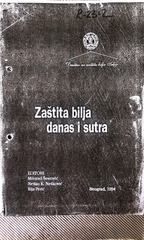Приказ основних података о документу
Selekcija pšenice na otpornost prema prouzrokovaču pepelnice
Selection for resistance to powdery mildew of wheat
| dc.creator | Stojanović, Srbobran | |
| dc.creator | Stojanović, Jovanka | |
| dc.creator | Jevtić, Radivoje | |
| dc.date.accessioned | 2024-04-18T11:13:46Z | |
| dc.date.available | 2024-04-18T11:13:46Z | |
| dc.date.issued | 1994 | |
| dc.identifier.uri | http://fiver.ifvcns.rs/handle/123456789/4500 | |
| dc.description.abstract | Pepelnica je veoma rasprostranjena i ekonomski značajna bolest pšenice u Srbiji. Stvaranjem i gajenjem otpornih sorata ostvaruje se najuspešnija zaštita. Ukrštanjem između osetljivih komercijalnih sorata (kragujevčanka 56, jugoslavija, balkan, kavkaz, posavka 2, skopljanka, partizanka i biserka) i donora Pm gena (FR 845, FR 8119, SC 780934, D-12, GA 83021, P 596-111/16 i P 518/1-5) stvoreno je 156 linija. Pedigre metoda je korišćena kod potomstva. Ova istraživanja su pokazala da se otpornost, uglavnom, nasleđivala dominantno. Otpornost donora je kontrolisana sa jednim, dva ili tri dominantna gena. Kod nekih kombinacija utvrđeno je komplementarno delovanje gena. Proučavana je, takođe, i produktivnost hibrida. Najznačajnije su linije koje su dobijene ukrštanjem skopljanka x FR 845, partizanka x FR 845 i jugoslavija x FR 8119. Njihov prinos zrna po glavnom stablu je bio od 2,38 do 4,01 grama. Za buduća istraživanja izdvojene su linije sa dobrom otpornošću i visokom produktivnošću. | sr |
| dc.description.abstract | Powdery mildew is a very frequent and economically important wheat disease in Serbia. An increasing importance is paid to the selection and growing of resistant cultivars. By crossing susceptible commercial cultivars (kragujevčanka 56, jugoslavija, balkan, kavkaz, posavka 2, skopljanka, partizanka and biserka) and Pm genes donor (FR 845, FR 8119, SC 780934, D-12, GA 83021, P 596-IIl/16 and P 518-1/5), 156 new lines were created. The pedigree method was used with the progenies. These studies showed that the inheritance of resistance was dominant. The resistance or donors was controlled by one, two or three dominant genes. In some combinations complementary effect of genes was found. Indicators of productivity of hybrids were also studied. The most important were the lines made by crossing skopljanka x FR 845, partizanka x FR 845 and jugoslavija x FR 8119. Their grain yield ranged from 2,38 to 4,01 grams per ear. Lines with good resistance and high productivity were separated for further investigation . | sr |
| dc.language.iso | sr | sr |
| dc.publisher | Beograd : Društvo za zaštitu bilja Srbije | sr |
| dc.rights | openAccess | sr |
| dc.rights.uri | https://creativecommons.org/licenses/by/4.0/ | |
| dc.source | Zaštita bilja danas i sutra, Beograd, 1994 | sr |
| dc.subject | pšenica | sr |
| dc.subject | otpornost | sr |
| dc.subject | oplemenjivanje | sr |
| dc.subject | pepelnica | sr |
| dc.subject | bolesti | sr |
| dc.subject | sorte | sr |
| dc.subject | wheat | sr |
| dc.subject | cultivars | sr |
| dc.subject | NS seme | sr |
| dc.subject | resistance | sr |
| dc.subject | breeding | sr |
| dc.subject | powdery mildew | sr |
| dc.title | Selekcija pšenice na otpornost prema prouzrokovaču pepelnice | sr |
| dc.title | Selection for resistance to powdery mildew of wheat | sr |
| dc.type | conferenceObject | sr |
| dc.rights.license | BY | sr |
| dc.citation.epage | 77 | |
| dc.citation.spage | 71 | |
| dc.description.other | Društvo za zaštitu bilja Srbije je organizovalo Treći jugoslovenski kongres o zaštiti bilja, koji je održan 3-7. oktobra 1994. godine u Vrnjačkoj Banji (iz Predgovora). | sr |
| dc.identifier.fulltext | http://fiver.ifvcns.rs/bitstream/id/9966/bitstream_9966.pdf | |
| dc.identifier.rcub | https://hdl.handle.net/21.15107/rcub_fiver_4500 | |
| dc.type.version | publishedVersion | sr |


